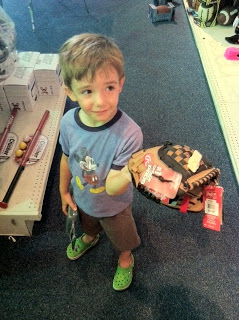Why Do We Buy?

When my son wants something, my first response is "why?" He's gotten to the point that he knows it's coming and now, most of the time, he doesn't even make me ask why. What's nice is that he's not yet socially influenced enough to use "everyone else has one" as his reason. His requests are usually supported with a (if not multiple) solid example of how he'd use it.

It seems, based on my PLN, that a lot of schools are buying technology BEFORE asking that question. I often see articles about "what to do with your school's (fill in the device)". I hear from people who’ve had technology purchased for them and then don't use it because it's too confusing. I see teachers trying to use something simply because they're told they are supposed to be using it. The accounting & finance teacher (and all around frugal human being) in me cringes at this. I can't help but think about the purchasing decision-making process that I teach, that I pound into the heads of my students, that my poor, poor, poor children and wife are subjected to every day, and wonder why this is so often ignored by our profession.
I don’t think that schools need to treat the purchasing process exactly the same as households. R&D, tinkering, testing, and exploring with new devices bring strong value to educational entities. However, it seems that the moderation of this activity has been swallowed up by premature excitement for "it" because "it" is technology and MUST be good for our kids. In today's (rightfully so) closely watched spending and usage of public resources, it's so crucial that we maintain a respectable decision-making process when purchasing anything. The last thing we can afford is to buy another iThing or gThing with no dedicated purpose, vision, or plan for which it will be used. We must figure out where we want to be BEFORE we start moving there. We have to envision the end and reverse engineer our buying decisions to ensure they actually will enhance our journey to that destination. Responsible consumers naturally do this. We are really pretty great at it. We buy food because we're hungry (unless I’m face to face with a Snickers bar at the grocery check out) and we need to be un-hungry. We work backwards (subconsciously) and get to the tool that will make us "un-hungry"... food.
Reverse engineering is a great process that, for decades, educators have been applying so well to curriculum design, emotional intelligence development, and student success planning. If we commit to leveraging this strength with digital purchasing decisions, we’ll set our teachers & instructional coaches up for a more meaningful and clear implementation experience.
So, let's make sure we maintain our credibility with our tax payers' money and give our teachers and students a more clear path for success. Let's make sure we are able to answer the questions my son knows he has to answer BEFORE buying. Why are we buying this? How are we going to use it?
We can create a building full of “why do we have these?” or one that’s asking “why didn’t we get these sooner?” In which building would you rather teach? More importantly, in which building would you rather your own child learn?
Cross-posted at busedcrev.blogspot.com.
Tools and ideas to transform education. Sign up below.
Sean Crevier is a Technology Integration Coach and Business Teacher at Vernon Hills High School in Illinois. He is a TEDx Organizer, Chrome Classroom Certified, FlipClass Certified, and Google Certified Teacher. Read more at busedcrev.blogspot.com.
